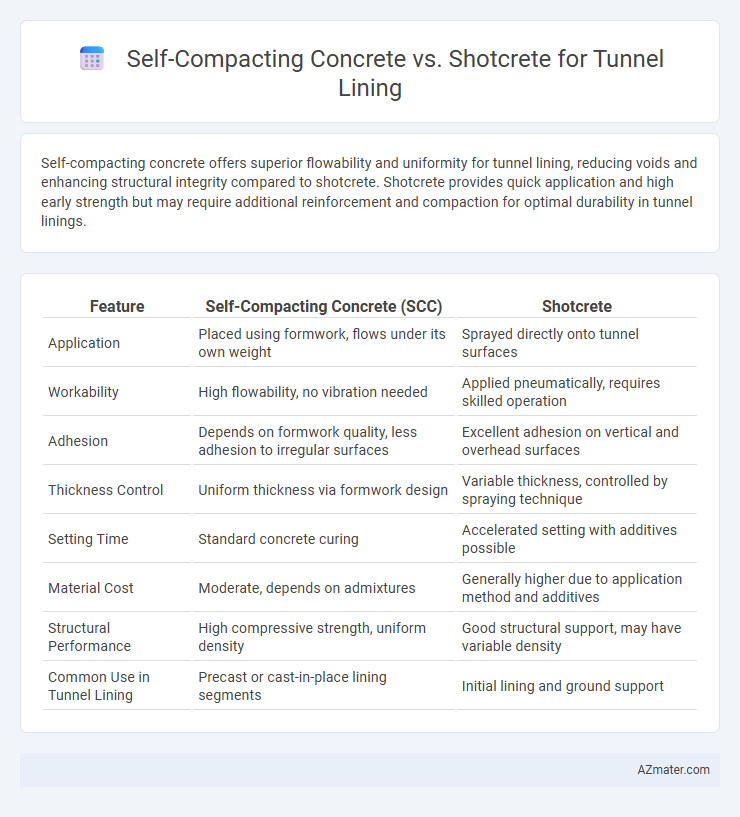Self-compacting concrete offers superior flowability and uniformity for tunnel lining, reducing voids and enhancing structural integrity compared to shotcrete. Shotcrete provides quick application and high early strength but may require additional reinforcement and compaction for optimal durability in tunnel linings.
Table of Comparison
| Feature | Self-Compacting Concrete (SCC) | Shotcrete |
|---|---|---|
| Application | Placed using formwork, flows under its own weight | Sprayed directly onto tunnel surfaces |
| Workability | High flowability, no vibration needed | Applied pneumatically, requires skilled operation |
| Adhesion | Depends on formwork quality, less adhesion to irregular surfaces | Excellent adhesion on vertical and overhead surfaces |
| Thickness Control | Uniform thickness via formwork design | Variable thickness, controlled by spraying technique |
| Setting Time | Standard concrete curing | Accelerated setting with additives possible |
| Material Cost | Moderate, depends on admixtures | Generally higher due to application method and additives |
| Structural Performance | High compressive strength, uniform density | Good structural support, may have variable density |
| Common Use in Tunnel Lining | Precast or cast-in-place lining segments | Initial lining and ground support |
Introduction to Tunnel Lining Methods
Tunnel lining methods primarily use self-compacting concrete (SCC) and shotcrete, each offering distinct advantages for structural stability and construction efficiency. SCC provides superior flowability and uniformity, reducing the need for vibration and minimizing voids within the lining. Shotcrete enables rapid application on irregular surfaces with excellent adhesion, making it suitable for immediate ground support in tunneling projects.
Understanding Self-Compacting Concrete (SCC)
Self-compacting concrete (SCC) is a high-performance material designed to flow under its own weight, filling complex tunnel molds without mechanical vibration, ensuring uniformity and reducing labor costs. Its superior workability and segregation resistance make SCC ideal for tunnel lining, where tight spaces and intricate formworks demand precise placement. Compared to shotcrete, SCC offers enhanced surface finish and homogeneity, minimizing voids and improving long-term durability in tunnel infrastructures.
Shotcrete: Overview and Application
Shotcrete is a versatile concrete application method involving pneumatically projecting a concrete mixture onto tunnel surfaces, offering high adherence and rapid set times ideal for tunnel lining. Its application in tunnel construction provides enhanced structural support and quick installation, particularly useful in irregular or complex tunnel geometries where conventional formwork is challenging. Shotcrete improves safety and reduces labor costs while enabling efficient reinforcement placement, making it a preferred choice for immediate rock stabilization and permanent lining in tunneling projects.
Key Performance Characteristics: SCC vs Shotcrete
Self-compacting concrete (SCC) offers superior flowability and uniformity in tunnel lining applications, ensuring void-free placement in complex formworks without the need for vibration. Shotcrete provides excellent adhesion and rapid setting on irregular tunnel surfaces, making it ideal for initial support in tunneling operations. SCC exhibits higher compressive strength and durability, while shotcrete excels in flexibility and quick application, influencing the choice based on structural requirements and construction speed.
Material Composition and Mix Design
Self-compacting concrete (SCC) for tunnel lining incorporates high powder content, fine aggregates, and superplasticizers to achieve flowability without segregation, ensuring uniform filling and consolidation in complex forms. Shotcrete relies on a dry or wet mix of cement, aggregates, and accelerators, designed for pneumatically projected application with immediate setting and high early strength, critical for rock support. The mix design of SCC emphasizes rheological properties for self-leveling, while shotcrete focuses on sprayability, adhesion, and rapid strength development.
Placement Techniques and Equipment Needs
Self-compacting concrete (SCC) for tunnel lining requires minimal vibration, relying on its high flowability to fill complex forms and dense reinforcement without segregation, which allows the use of standard concrete pumps and simple formworks. Shotcrete placement involves pneumatically spraying concrete onto tunnel surfaces, necessitating specialized spraying equipment and skilled operators to control rebound and ensure proper compaction and adhesion. Equipment needs for SCC emphasize efficient pumping systems, while shotcrete demands dedicated shotcrete machines and nozzles optimized for high-velocity application in confined tunnel environments.
Durability and Long-Term Performance
Self-compacting concrete (SCC) provides superior durability for tunnel linings due to its dense microstructure and uniform consolidation, reducing permeability and enhancing resistance to chemical attacks and freeze-thaw cycles. Shotcrete, while offering fast application and strong adhesion, generally exhibits higher porosity and potential for rebound, which can compromise long-term performance under aggressive environmental conditions. Selecting SCC over shotcrete can significantly improve tunnel lining lifespan by minimizing cracking and deterioration caused by mechanical and environmental stresses.
Construction Efficiency and Project Timelines
Self-compacting concrete (SCC) enhances construction efficiency in tunnel lining by eliminating the need for mechanical vibration, allowing faster placement and consistent quality in complex formworks. Shotcrete offers quicker application on irregular surfaces and enables immediate support, reducing overall project timelines, especially in tunneling environments with challenging geometries. Choosing between SCC and shotcrete depends on project-specific factors such as lining complexity, required strength, and site accessibility to optimize both construction speed and durability.
Cost Considerations and Economic Analysis
Self-compacting concrete (SCC) generally incurs higher initial material costs compared to shotcrete due to its specialized admixtures and mix design, but offers reduced labor expenses and faster application rates in tunnel lining projects. Shotcrete often presents lower upfront costs but may require additional skilled labor and time-consuming rebound cleanup, increasing overall project expenses. Economic analysis must balance SCC's premium prices against savings in labor, cycle time, and long-term durability to determine the most cost-effective solution for specific tunneling conditions.
Best Practices for Choosing the Optimal Tunnel Lining Method
Self-compacting concrete (SCC) offers superior flowability and uniformity, making it ideal for complex tunnel geometries requiring high surface quality without vibration. Shotcrete provides rapid application and strong early-age strength, beneficial in variable ground conditions and quick lining needs. Best practices prioritize soil stability, tunnel shape, project timeline, and desired finish quality to select between SCC's precision and Shotcrete's adaptability for optimal tunnel lining.

Infographic: Self-compacting concrete vs Shotcrete for Tunnel Lining
 azmater.com
azmater.com